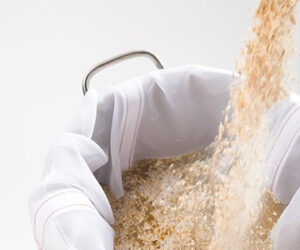Understanding Enzymes

What are enzymes, anyway?
First and foremost, enzymes are proteins. They are a specific type of protein with an important role. They catalyze biochemical reactions, which means that they enable a reaction to occur quickly and at the temperature of living organisms. They act on small molecules to join them together and make them larger, they take large molecules and break them up into smaller ones, or they rearrange molecules into something different.
Each biochemical reaction is catalyzed by a very specific enzyme. For example, maltose is created by joining two glucose molecules, and this is done by a specific enzyme. A different enzyme is responsible for breaking the maltose back into two glucose molecules. Maltose also can be created by breaking a two-molecule chunk off a long chain of glucose molecules — and this is done by yet another enzyme!
Being a protein, enzymes are made of several thousand different amino acids (selected from the 20 naturally occurring amino acids) joined together. This chain is then folded and coiled to form a specific shape. This shape is suited to the specific job the enzyme must do, and so it is important. However, the shape is relatively fragile and can be damaged by excessive heat or agitation, or chemical attack, which will render the enzyme unable to catalyze a reaction. This is called “denaturing” the enzyme and once the structure is destroyed, rarely can the enzyme be renatured.
The molecule the enzyme acts on is called the “substrate” and the enzyme is usually named after this substrate, with the letters “ase” added (beta glucanase acts on beta glucan, and alpha amylase is one enzyme that acts on amylose, a component of starch). The rate at which a reaction occurs is affected by temperature, and enzymes catalyze reactions more quickly as temperature increases. But they also are denatured by heat, and reach peak activity just before they are destroyed.
Mashing Enzymes from A to B
In a brewer’s mash we are concerned with the activity of two main enzymes, alpha and beta amylase.
Alpha amylase is the enzyme responsible for breaking large, complex, insoluble starch molecules into smaller,soluble molecules. It is stable in hot, watery mashes and will convert starch to soluble sugars in a temperature range from 145 to 158 °F (63 to 70 °C). It requires calcium as a co-factor.
Beta amylase is the other mash enzyme capable of degrading starch. Through its action, it is the enzyme largely responsible for creating large amounts of fermentable sugar. It breaks starch down systematically to produce maltose. Beta amylase is active between 131 and 149 °F (55 and 65 °C). But like all enzymes, its activity reaches a peak, declines, and then drops precipitously as temperature increases. The rate is also dependent on the amount of enzyme present. It takes time for all of the enzyme to be destroyed, but what is still intact works very quickly. So as the mash temperature approaches 149 °F (65 °C), beta amylase is operating at its fastest rate but it is also being denatured.
This may seem trivial, but at these higher temperatures the denaturation is so rapid that the enzyme is mostly gone in less than 5 minutes. Also, in a homebrewer’s mash tun, where the grain may be poured into very hot water, the exposure to very high heat for the few seconds before the mixture becomes homogenous may work to destroy the fragile enzymes.
This means that, in a practical sense, the manipulation of beta amylase activity can be utilized to control the fermentability of the wort. If the mash is allowed to “stand” at a temperature that favors the action of beta amylase, then agreater proportion of the sugars extracted from the malt will be maltose and hence the wort will prove more fermentable.
In my commercial breweries, I found that changing the mash temperature from 149 to 156 °F (65 to 69 °C) raised the beer’s terminal gravity from 1.008 to 1.014. This is a significant difference.
__________
Temperature Rests in the Mash
- 113 to 122 °F (45 to 50 °C) protein and beta glucanase rest
- 144° to 149 °F (62 to 65 °C) fermentability rest
- 158° to 167 °F (70 to 75 °C) extract rest
- 172 °F (78 °C) mash-off temperature
__________
What these Enzymes Do
Both of these enzymes act in consort to degrade barley starch to produce a range of sugars present in wort. Below a certain temperature (145 °F/63 °C), alpha amylase activity is low and so the large starch molecules remain insoluble. Above a certain temperature (149° F/65 °C), beta amylase is denatured significantly, limiting the amount of fermentable sugars that can be extracted into the wort. This leaves a small “window” where a brewer can operate and have influence over the types of sugars that end up in the wort. A lower temperature results in a wort that is more fermentable but may yield slightly less, while a higher temperature will yield less fermentability but increased extract efficiency.
The thickness of the mash has a similar, albeit less dramatic, influence over yield and fermentability. A thicker mash offers protection to the more fragile enzyme, beta amylase, and so increases fermentability, whereas a thinner, more watery mash favors a higher extract. After these enzymes have acted on the barley starch in the mash tun we are left with wort that contains around 15 percent simple sweet sugars like glucose, fructose and sucrose. Most of these were present in the malt in the first place and simply dissolved into the wort. We also are left with larger pieces of the original starch molecule known as dextrins (20 to 35 percent), which popular belief would have contribute to mouthfeel. They are probably not large contributors to this perception in beer, however, but can be rapidly attacked by amylases in the mouth to yield glucose and hence a sweet flavor. The remaining extract is maltose (and a little maltotriose), and since the primary source of maltose is the action of beta amylase it is apparent how important control of that enzyme’s activity must be in a mash.
A paper written by Professor E.J. Manners at Heriot-Watt University in Scotland in 1974 proposed that there is only one enzyme brewers need to concern themselves with when mashing, and that is alpha amylase. He pointed out that at the temperature required to render barley starch soluble (the gelatinization temperature – which is 140 °F/60 °C (in barley), all the other enzymes are denatured so quickly that their action is insignificant. That may indeed be the case in a single-temperature infusion mash, where the malt is mixed with hot water only once to achieve an overall temperature that favors conversion. The author was also discussing using English pale malt, which is malted specifically with this type of brewing in mind. In their book Brewing, published 21 years later, Dr. Michael Lewis and Dr. Tom Young proposed that it is in fact the consorted effort of beta and alpha amylase, working together within a narrow temperature range, that has a far greater effect on the final beer, due to its role in determining the wort’s fermentability.
While many enzymes are denatured by heat and agitation, American two-row malt contains such an enormous surplus of the two main enzymes that their activity will have an impact prior to their demise in the mash.
The role of mash pH
Mash pH is another factor that affects the activity of the various enzymes. A mash carried out using distilled water ends up with a pH in the region of 5.8 to 6.0. The presence of enough calcium ions in the water causes the mash pH to drop down into the 5.5 to 5.6 range. Additional calcium ions can drive the pH down to 5.2, where we get within optimal conditions for the two main mash enzymes. pH in the optimal range also helps to insulate the enzyme a little from the effects of temperature.
Protease enzymes are still an area of controversy among brewing scientists. Historically, brewers from a British pedigree have dismissed the action of enzymes that break down and solubilize potentially harmful proteins in the mash. Understandably, since it was discovered that with a variety of denaturation temperatures, even as high as 144 °F (62 °C), virtually no protease enzyme would survive to be effective in an infusion mash. Likewise, a well-modified, highly kilned British malt is unlikely to contain much in the way of protease enzymes in the first place.
Research at the University of California-Davis in the 1980s, focusing on protease activity in the mash, concluded that so little of the protease enzymes survive kilning in modern malts that the presumed benefits of a “protein rest” were more likely due to physical factors regarding protein solubility than enzymic factors.
However, there is strong evidence that some protein degradation is occurring, namely the enzymes responsible for the production of additional amino acids in the wort. Amino acids are a vital yeast nutrient and so when high levels of adjuncts are used, additional amino acids can be a big benefit. Low temperature rests may even double the amounts of amino acids in the wort. In an all-malt wort this can lead to a surplus of amino acids and affect beer flavor and negatively affect a beer’s microbiological stability.
Textbooks continue to discuss the action of protease enzymes that break down large proteins into smaller ones, however, in a temperature range of 122 to 140 °F (50 to 60 °C). The Practical Brewer, published by the Master Brewers Association of the Americas, states that there is just as much proteolysis in mashing as there is during malting, and numerous other texts discuss the degradation of complex proteins into polypeptides and peptides. The larger soluble breakdown products of the big proteins in barley are responsible for enhancing foam and palate fullness and cause haze, while the smallest provide yeast nutrition.
Beta glucanase enzymes are important because of the negative effects beta glucan can have on beer quality and processing in a commercial brewery. Beta glucan is a gummy carbohydrate and it can dramatically increase the viscosity of both wort and beer. This increased viscosity will lead to dramatic problems with wort separation and beer filtration.
Neither of these issues is likely to trouble homebrewers since wort separation just takes a little longer and few homebrewers feel the need to filter their beer. This enzyme helps break down large beta glucans into much smaller ones, making them less problematic. It is active in low temperature mashes to a limited extent.
Phytase is an enzyme that converts phytic acid (an enormous source of phosphates) in barley into free phosphates, which are vital in the malting process as enzyme co-factors and have a vital role in pH regulation. It is almost wholly denatured by kilning in a modern malt but in an extremely under-modified, lightly kilned malt, and using a decoction system, this enzyme may be a factor in bringing the mash pH into line.
Lipoxygenase is another enzyme of interest to brewers. Speculation that this enzyme may have an important role in beer staling has kept the brewing scientists embroiled in friendly arguments for the last several years. Proponents claim it causes the oxidation of lipids in the mash to produce stale flavor precursors in beer, while opponents argue its relevance and influence. Either way, it’s not something a homebrewer should be concerned with.
The “Brewer’s Window” graph that appears above is adapted from the book Brewing by Dr. Michael Lewis and Dr. Tom Young.




